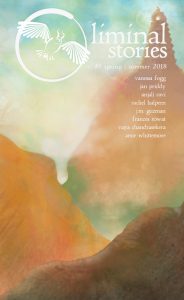Karen Burnham Reviews Short Fiction: Strange Horizons, Samovar, Giganotosaurus, Big Echo, Liminal, and Red Sun
 Strange Horizons 10/18
Strange Horizons 10/18
Samovar 9/18
Giganotosaurus 11/18
Big Echo 8/18
Liminal Stories 8/18
Red Sun #3
Fall brings expanded coverage from Strange Horizons as their successful annual fundraiser “unlocked” extra stories in October. “The Fortunate Death of Jonathan Sandelson” by Margaret Killjoy is one such story, a cyber-punkish tale of left wing activists using doxxing/IT/hacking tools to go after abusive corporate and government powers. Jeje has been following and harassing Sandelson for some time when another entity crosses the line and kills him. She’s implicated, so she has to figure out whodunnit while keeping ahead of law enforcement. I especially liked the outcome when she finds and confronts the killer, leading to a much more interesting climax.
Samovar is Strange Horizons‘s sister magazine dedicated to works in translation. Their September story is “Children of the Endless Sea” by Savi Kauppila, translated from Finnish by the author. Set in a world ruined by climate change and largely flooded, the narrator is a survivor in several senses of the word. In a spare narrative we get his life story – growing up in a flotilla full of people who aren’t quite baseline humans anymore, fighting off scavengers and scavenging in turn, eventually being captured and sold to some who still live on high ground, escaping and making a life for himself. While there’s a distance to the narrative voice that feels slightly unusual for a first person narrator, the world building is especially impressive.
Giganotosaurus for November gives us “Still Life” by Victoria Feistner, set in a near-future after an apocalypse of unspecified nature. Oliver and Gunny are navigating part of the ravaged UK, traveling from Scotland to York. Gunny has an ATV, a fuel converter, and some guns, and she rescues Oliver, whom she recognizes from a YouTube series. They make an unlikely pair – he’s a Londoner and she’s trying to get back to North America – but a good one. Oliver is quite judgmental about Gunny’s choices, especially her use of violence, but he’s eventually faced with a choice that throws his moral concerns right in his face. This is a slightly cosier catastrophe than something like Mad Max, but I think that makes Oliver’s personal journey into moral ambiguity even more telling.
I want to make sure that 2018 doesn’t disappear behind the horizon without mentioning some of the quarterly magazines that came out last year. Big Echo (“an online journal of critical science fiction”) released its ninth issue in August. Their mission statement translates into scalpel-sharpened stories aimed right at the many uses and constructions of narrative. “Ruin’s Cure” by Vajra Chandrasekera opens the issue with a story of revisionist time travel. A time traveler to the nigh-mythic past of Sri Lanka is obviously trying to ensure a very specific outcome by becoming an advisor to a young king, only barely trying to disguise his origins. The king is the narrator, puzzling over the “historian’s” ever-changing black lingam with its square symbols, as well as his strange accent. The time traveler has obviously trod this path more than once, and we’re invited to ponder the role of myth and history in shaping current events, and how that narrative can be manipulated.
“Water Exchange, Version 8123…” by Saba Waheed uses time travel to expose capitalist systems that exploit labor. In a version of our near future, industry imports labor from a drought-ridden farther future, trading them water for their workers. The workers stay for decades but are returned to exactly the moment they left – appearing to their families to age 30 years overnight. The main character, Leena, saw this happen to her mother and now is assigned to do it herself. At her factory in the middle of nowhere she is befriended by a journalist, Jackie, who gives her a hacked tablet so she can see the different ways the time traveling society has tried to make history pan out. They’re told that there is no way to avoid ruining Leena’s future, but that’s a narrative begging to be questioned. Finally “The Five Secret Truths of Demonkind” by Benjanun Sriduangkaew puts an immortal chitinous demon in an ingenious scenario – literally climbing and infiltrating a wandering fortress of virtue, hoping to confront the god within. The setting is striking as she meets various parasites living on the fortress’ lower walls, encountering the remains of other demons who have tried to scale the walls, and ultimately coming into dialog with a divine entity. I suspect this story will be read very differently by different readerships. All the stories in this issue could have used a little more editing – there are occasional discordant turns of phrase or incongruous details – but all of them are extremely vivid and insightful in what they’re trying to do.
Liminal Stories (“an online literary magazine publishing the beautiful, heartbreaking, and strange”) published its fifth issue in August as well. I was especially impressed by Rachel Halpern‘s “Till Human Voices Wake Us“. A group of people who had been taken by the sea years ago are found gasping on the shore. They had been held and ill-treated by mermaids for years, and no one knows why they were returned. Helped (and questioned) first by the police and then by their families, they support each other as best they can as they try to readjust – and slowly regain their sense of who they were before they were taken. There’s a depth to how Halpern portrays the relationships between the returned and their families and how the dynamics play out, which is impressive in something slightly shorter than a novelette.
I’m always glad to encounter a new-to-me venue, and I was happy to receive the third issue of Red Sun, a speculative fiction magazine largely by and for military veterans. Their lead story in the Autumn issue, “Caroline” by Aeryn Rudel is short but effective horror. A woman is attempting to raise her two children in a household where her husband must be kept in the basement and she can only visit him for “rehab” sessions carrying a shotgun. She’s hoping to help him regain his literal humanity, but their young daughter misses her father immensely and doesn’t understand why she can’t see him. The sense of alienation and immense difficulty surrounding re-integration is poignant and tragic. I was also impressed by another horror story, “The Starlight Circus” by Tara Calaby. This one takes scary clowns and ramps it up to 11, as a widower’s son is possessed by some entity related to a clown they met at a traveling circus. Steve, the dad, is trying to overcome the substance abuse that he fell into after his wife’s death, and trying to step up to be a good dad to his son. I felt like his struggles and reactions were very well characterized, especially when put into contrast with the clown’s story. I usually skip stories where horrific things happen to children, but I was drawn to keep reading to the end. I look forward to seeing more from this magazine.
Karen Burnham is an electromagnetics engineer by way of vocation, and a book reviewer/critic by way of avocation. She has worked on NASA projects including the Dream Chaser spacecraft and currently works in the automotive industry in Michigan. She has reviewed for venues such as Locus Magazine, NYRSF, Strange Horizons, SFSignal.com, and Cascadia Subduction Zone. She has produced podcasts for Locusmag.com and SFSignal.com, especially SF Crossing the Gulf with Karen Lord. Her book on Greg Egan came out from University of Illinois Press in 2014, and she has twice been nominated in the Best Non Fiction category of the British SF Awards.
This review and more like it in the January 2019 issue of Locus.
 While you are here, please take a moment to support Locus with a one-time or recurring donation. We rely on reader donations to keep the magazine and site going, and would like to keep the site paywall free, but WE NEED YOUR FINANCIAL SUPPORT to continue quality coverage of the science fiction and fantasy field.
While you are here, please take a moment to support Locus with a one-time or recurring donation. We rely on reader donations to keep the magazine and site going, and would like to keep the site paywall free, but WE NEED YOUR FINANCIAL SUPPORT to continue quality coverage of the science fiction and fantasy field.








